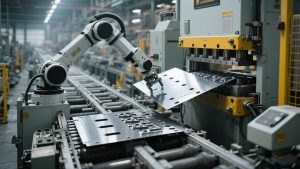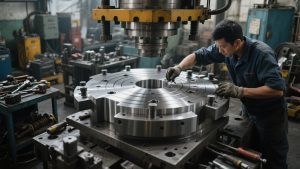Metal Stamping – High-Efficiency Manufacturing for Precision Components
Introduction
Metal stamping is a critical manufacturing process used to produce high-volume, complex metal parts with speed and precision. Widely adopted in industries such as automotive, electronics, aerospace, and consumer products, stamping enables manufacturers to meet tight tolerances while minimizing production costs.
This article explores the stamping process, common applications, material choices, and current industry trends that are shaping the future of stamped metal components.
-300x169.jpg)
What Is Metal Stamping?
Metal stamping is a cold-forming process that involves feeding flat sheet metal into a stamping press where a die is used to form the metal into a desired shape. The process includes several techniques:
Punching – creating holes or cutouts
Bending – forming angled geometries
Embossing – adding raised or recessed features
Coining – producing fine detail and surface features
Stamping is especially well-suited for high-volume production because of its fast cycle time and repeatability.
-300x169.jpg)
Key Industries and Applications
Automotive
Body panels, brackets, clips, and reinforcements
High-speed stamping enables consistent quality at large volumes
Electronics
Precision contacts, terminals, EMI/RFI shielding parts
Thin-gauge metal stamping supports miniaturized devices
Appliances
Enclosures, frames, and support components
Durable, cost-effective production with minimal waste
Aerospace
Lightweight structural components, fuel system parts
Tight tolerances required for safety-critical applications

Common Materials Used in Stamping
Carbon Steel – Strong, economical, used for automotive and structural parts
Stainless Steel – Corrosion-resistant, ideal for medical and food-grade applications
Aluminum – Lightweight, used in aerospace and EV industries
Copper & Brass – High conductivity, common in electrical applications
Material choice impacts tooling wear, part performance, and overall production efficiency.
Advantages of Metal Stamping
✅ High Production Speed – Ideal for millions of parts with minimal downtime
✅ Low Cost Per Unit – Economies of scale improve cost-efficiency
✅ Consistent Quality – Precision dies ensure repeatability
✅ Material Utilization – Advanced nesting and blanking reduce waste

Industry Trends
Progressive Die Stamping – Combines multiple operations in a single pass, reducing handling and increasing speed
Precision Stamping for EVs – New electric vehicle components require tighter tolerances and lighter materials
Tooling Automation – CNC-controlled dies and sensors improve uptime and quality assurance
Green Manufacturing – Reduced scrap, energy-efficient presses, and recyclable materials align with sustainability goals
Conclusion
Metal stamping remains one of the most cost-effective, scalable, and versatile manufacturing processes available. As industries evolve toward lightweight, high-precision components—especially in the EV and electronics sectors—advanced stamping technologies will play a vital role in the global manufacturing supply chain.
